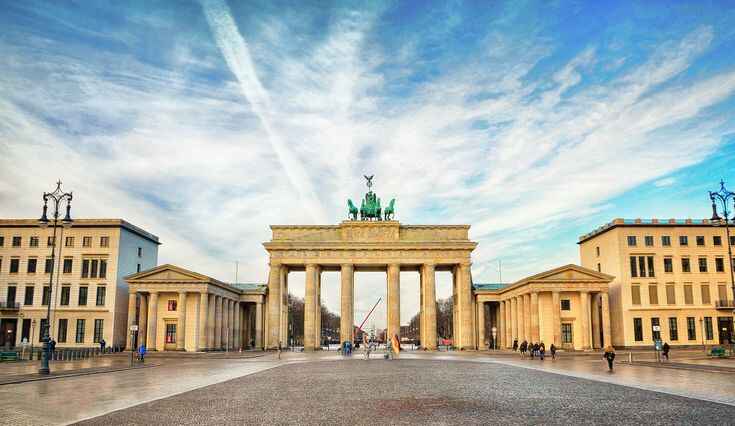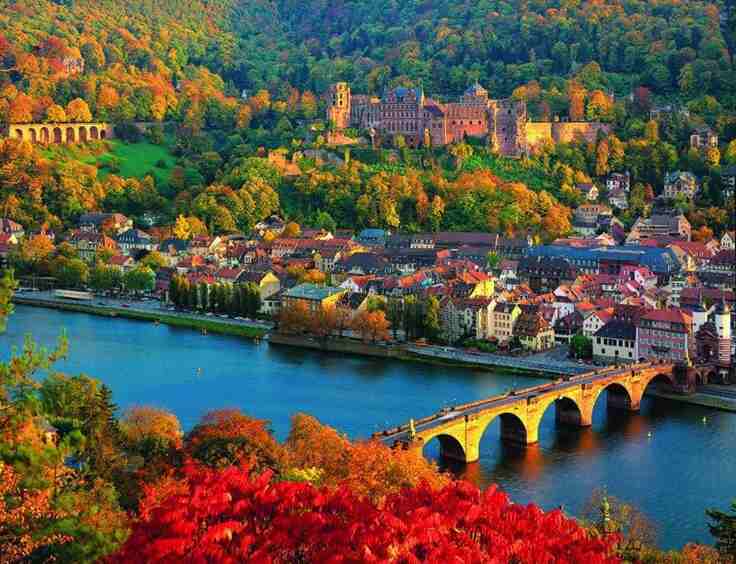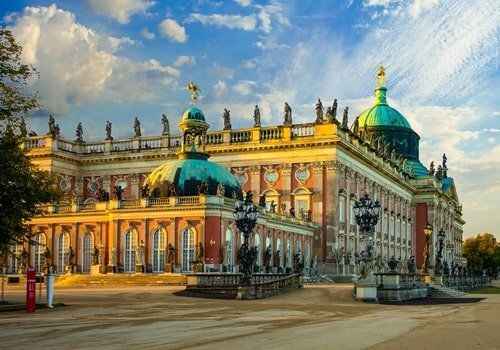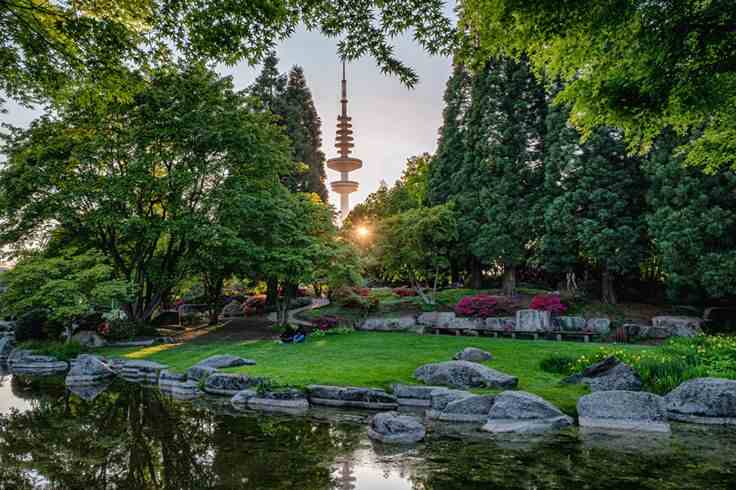Best Places To Travel In Germany
1.Berlin (capital of Germany)
Brandenburg Gate

The Brandenburg Gate, located in Berlin, is one of Germany’s most recognizable landmarks. Erected between 1788 and 1791, it was originally commissioned by King Frederick William II of Prussia as a symbol of peace. The gate is a neoclassical structure with twelve Doric columns, creating five passageways, and is crowned by the Quadriga, a chariot drawn by four horses.
In Berlin, this iconic monument represents both the division and reunification of Germany, having stood as a symbol of the Cold War during the Berlin Wall era and later becoming a powerful symbol of German unity. Berlin itself is the vibrant capital of Germany, known for its rich history, dynamic culture, and significant architectural landmarks. The city played a crucial role in shaping modern Europe and continues to be a major cultural and political hub in Germany.
Best Months to Visit
The best time to visit the Brandenburg Gate in Berlin is typically during the spring (April to June) or fall (September to October). During these months, the weather is generally mild and pleasant, with fewer crowds compared to the peak summer season.
- Spring: The weather is warming up, and Berlin’s parks and gardens are in full bloom, providing a picturesque backdrop for sightseeing.
- Fall: The temperatures are still comfortable, and the city’s autumn colors add a beautiful dimension to your visit.
Summer (July and August) is also a good time to visit if you enjoy warm weather and vibrant city life, though it can be quite crowded. Winter (December to February) is colder and can be grey, but the Brandenburg Gate an
Open Days And Timing
The Brandenburg Gate in Berlin is open to the public 24/7, as it is an outdoor monument and does not have specific opening or closing hours. You can visit it at any time of day or night.
Ticket
Visiting the Brandenburg Gate itself is free of charge as it is an outdoor monument. You do not need a ticket to view or photograph the gate.
Near By Location
Reichstag Building: Just a short walk from the Brandenburg Gate, this historic parliament building features a stunning glass dome offering panoramic views of Berlin. You can also explore the building’s rich history and architecture.
Memorial to the Murdered Jews of Europe (Holocaust Memorial): A moving and somber memorial dedicated to the victims of the Holocaust, located a short distance from the Brandenburg Gate.
Tiergarten: Berlin’s central park, perfect for a leisurely stroll or a relaxing break. It’s a large green space right next to the Brandenburg Gate.
Berlin Cathedral (Berliner Dom): A magnificent cathedral with impressive architecture and a beautiful interior. It’s located a bit further east along Unter den Linden.
Unter den Linden: A historic boulevard running from the Brandenburg Gate to Berlin Cathedral, lined with shops, restaurants, and notable buildings.
Berlin Wall Memorial: Located on Bernauer Strasse, it offers insights into the history of the Berlin Wall and is a short distance from the Brandenburg Gate.
Checkpoint Charlie: The famous former border crossing point of the Berlin Wall, now a museum that provides a detailed account of the Cold War era. It’s a bit further south from the Brandenburg Gate.
Potsdamer Platz: A major square and transportation hub known for its modern architecture, shopping centers, and entertainment options. It’s a short walk from the Brandenburg Gate.
2.Baden-Württemberg
Heidelberg

Heidelberg, located in the state of Baden-Württemberg in southwestern Germany, is renowned for its romantic charm and historic significance. The city is famously home to Heidelberg Castle, a majestic fortress overlooking the Neckar River, and the old town, with its narrow streets and baroque architecture. Heidelberg is also notable for its prestigious university, the oldest in Germany, which adds to the city’s vibrant and youthful atmosphere.
Baden-Württemberg, the state where Heidelberg is situated, is known for its diverse landscapes, from the dense Black Forest to the scenic shores of Lake Constance. The state combines picturesque towns, historical landmarks, and cultural attractions with modern amenities. Stuttgart, the state capital, is a hub of automotive innovation, while the region’s natural beauty offers ample opportunities for outdoor activities and relaxation.
Best Months to Visit
Heidelberg is a beautiful city year-round, but the best months to visit are generally:
Spring (April to June): Spring is an excellent time to explore Heidelberg. The weather is mild, and the city’s gardens and parks are in full bloom, creating a picturesque setting. It’s also less crowded compared to summer.
Fall (September to October): Autumn offers cooler temperatures and stunning fall colors, particularly in the surrounding countryside and the Philosophenweg (Philosopher’s Walk). The city is less crowded than in summer, making for a more relaxed visit.
Summer (July to August): Summer provides warm weather, which is ideal for walking around the city and enjoying outdoor cafes. This is also when many festivals and cultural events take place. However, it can be busy with tourists.
Winter (November to February): Winter brings a quieter atmosphere, and Heidelberg’s Christmas market is a charming experience with festive decorations and local treats. The weather can be cold and sometimes snowy, but the city’s historic ambiance is still captivating.
Open Days And Timing
Heidelberg is a vibrant city with many attractions that have varying opening days and times. Here are some key places to visit and their general opening hours:
Heidelberg Castle:
- Opening Hours: Typically open daily from 8:00 AM to 6:00 PM (April to October) and from 10:00 AM to 5:00 PM (November to March). Hours can vary, so it’s a good idea to check their official website for the most current information.
- Closed: January 1 and December 24-26.
Heidelberg Old Town (Altstadt):
- Open Daily: The Old Town is open year-round and accessible at all times. It’s a great area for exploring shops, cafes, and historic sites.
Philosophenweg (Philosopher’s Walk):
- Open Daily: This scenic walking path is open year-round and is a popular spot for views of the city and the castle.
Heidelberg University:
- Opening Hours: The university’s historic buildings and libraries have specific visiting hours, which can vary. Public tours are occasionally available; check the university’s official website for details.
Heidelberg Zoo:
- Opening Hours: Generally open daily from 9:00 AM to 6:00 PM (April to October) and from 9:00 AM to 4:00 PM (November to March). Hours can vary by season and special events.
Heiliggeistkirche (Church of the Holy Spirit):
- Opening Hours: Typically open daily from 10:00 AM to 6:00 PM, but it’s best to check for any changes due to services or special events.
Old Bridge (Alte Brücke):
- Open Daily: The bridge is accessible year-round and is a historic landmark with great views of the Neckar River.
Ticket
Heidelberg Castle:
- Admission: Typically, a combination ticket for the castle and its exhibits costs around €12 to €14. This may include entrance to the castle grounds, the castle museum, and the German Pharmacy Museum.
- Guided Tours: Available for an additional fee, usually around €5 to €10 per person.
Heidelberg University Library and Historic Rooms:
- Admission: Entry to the university’s historic rooms may require advance booking or a small fee. It’s best to check the university’s website for current details and availability.
Heidelberg Zoo:
- Admission: Tickets are generally priced around €10 for adults and €5 for children (ages 6 to 15). There are often discounts for groups and families.
Heiliggeistkirche (Church of the Holy Spirit):
- Admission: The church is usually open to visitors free of charge, though donations are appreciated.
Philosophenweg (Philosopher’s Walk):
- Admission: Free. The walk is a public path with no entry fee.
Old Bridge (Alte Brücke):
- Admission: Free. The bridge is accessible year-round without any cost.
Near By Location
Heidelberg is surrounded by several interesting destinations worth exploring. Here are some nearby locations you might enjoy:
Schwetzingen: About 15 kilometers (9 miles) from Heidelberg, Schwetzingen is known for its beautiful Schwetzingen Palace and gardens, which are perfect for a leisurely stroll.
Speyer: Approximately 30 kilometers (19 miles) away, Speyer is a historic town famous for its Speyer Cathedral, a UNESCO World Heritage site, and its charming old town.
Heidelberg’s Surrounding Vineyards: The region around Heidelberg is renowned for its vineyards. The nearby wine villages like Leimen and Dossenheim offer scenic wine tours and tastings.
Neckarsteinach: Located about 20 kilometers (12 miles) downstream from Heidelberg, Neckarsteinach is known for its four medieval castles that overlook the Neckar River. It’s a great spot for hiking and exploring.
Hockenheim: Around 20 kilometers (12 miles) from Heidelberg, Hockenheim is famous for the Hockenheimring race track, which hosts various motorsport events.
Baden-Baden: About 70 kilometers (43 miles) away, Baden-Baden is a renowned spa town known for its thermal baths, historic casino, and elegant architecture.
Frankfurt: Approximately 90 kilometers (56 miles) away, Frankfurt is a major city with attractions like the Römer, St. Bartholomew’s Cathedral, and a vibrant cultural scene.
Mannheim: Around 20 kilometers (12 miles) from Heidelberg, Mannheim offers a modern city experience with attractions like the Mannheim Palace and the Luisenpark.
3.Brandenburg
Potsdam

Potsdam, the capital of Brandenburg, is a historic city renowned for its stunning palaces and gardens. It’s famously home to Sanssouci Palace, the former summer residence of Frederick the Great, which features exquisite Rococo architecture and beautifully landscaped gardens. Potsdam also boasts other significant sites such as the New Palace and Cecilienhof Palace, where the Potsdam Conference took place after World War II.
Brandenburg, the state surrounding Berlin, offers a diverse array of attractions, including the charming city of Potsdam and natural wonders like the Spreewald biosphere reserve. The state is known for its historic towns, picturesque lakes, and rich cultural heritage, making it a region with a blend of historical significance and scenic beauty.
Best Months to Visit
The best months to visit Potsdam are generally:
Spring (April to June): Spring is a delightful time to explore Potsdam, with mild temperatures and blooming gardens, including the renowned Sanssouci Park. The weather is pleasant, and the city’s parks and palaces are in full bloom.
Fall (September to October): Autumn offers cooler temperatures and beautiful fall colors, especially in the parks and gardens. It’s also less crowded compared to the summer months, providing a more relaxed experience.
Summer (July to August): Summer is popular for tourists due to warm weather and longer days, perfect for exploring the outdoor attractions and enjoying boat trips on the nearby lakes. However, it can be quite busy with tourists.
Winter (November to February): Winter is quieter and offers a different charm, with the possibility of festive Christmas markets and seasonal events. The weather can be cold and gray, but it’s a cozy time to visit if you enjoy winter atmospheres and fewer crowds.
Open Days And Timing
Sanssouci Palace:
- Opening Hours: Typically open daily from 10:00 AM to 6:00 PM (April to October) and from 10:00 AM to 5:00 PM (November to March). The palace is closed on Mondays.
- Guided Tours: Available, and it’s advisable to check the schedule and book in advance.
New Palace:
- Opening Hours: Generally open daily from 10:00 AM to 6:00 PM (April to October) and from 10:00 AM to 5:00 PM (November to March). Closed on Mondays.
- Guided Tours: Available and recommended for a comprehensive visit.
Cecilienhof Palace:
- Opening Hours: Usually open daily from 10:00 AM to 6:00 PM (April to October) and from 10:00 AM to 5:00 PM (November to March). Closed on Mondays.
- Guided Tours: Offered and can be booked in advance.
Potsdam’s Dutch Quarter (Holländisches Viertel):
- Open Daily: The Dutch Quarter is a public area with shops, cafes, and historical buildings, accessible at all times.
Spreewald:
- Open Daily: The Spreewald is a natural reserve open year-round. Boat tours and other activities may have seasonal schedules.
Botanical Gardens Potsdam:
- Opening Hours: Generally open daily from 9:00 AM to 7:00 PM (April to October) and from 9:00 AM to 4:00 PM (November to March).
Filmpark Babelsberg:
- Opening Hours: Typically open from 10:00 AM to 6:00 PM, with seasonal variations. It’s closed on certain weekdays in the off-season.
Ticket
Sanssouci Palace:
- Admission: A standard ticket for Sanssouci Palace usually costs around €12.00. Combined tickets for Sanssouci Park and other palaces (e.g., New Palace) are available for approximately €20.00 to €25.00.
- Guided Tours: Additional fees apply for guided tours, often around €5.00 to €10.00 per person.
New Palace:
- Admission: Tickets typically cost around €12.00. A combined ticket with other sites in the park may be available.
- Guided Tours: Available for an additional fee.
Cecilienhof Palace:
- Admission: Entrance usually costs around €12.00. A combined ticket with other palaces in Potsdam may be available.
- Guided Tours: Additional fees may apply.
Botanical Gardens Potsdam:
- Admission: Tickets are generally priced around €6.00 for adults and €3.00 for children and students.
Filmpark Babelsberg:
- Admission: Typically costs around €30.00 for adults and €22.00 for children (ages 4-14). Prices may vary for special events or seasonal changes.
Spreewald Boat Tours:
- Admission: Prices for boat tours vary depending on the tour length and provider, typically ranging from €15.00 to €30.00 per person.
Near By Location
Berlin: Just a short drive or train ride from Potsdam, Berlin offers a wealth of attractions including the Brandenburg Gate, the Berlin Wall Memorial, Museum Island, and vibrant neighborhoods like Kreuzberg and Mitte.
Schwielowsee: About 20 kilometers (12 miles) from Potsdam, this picturesque lake is ideal for outdoor activities like boating, swimming, and hiking. It’s a peaceful spot for a relaxing day trip.
Spreewald: Approximately 40 kilometers (25 miles) from Potsdam, this unique biosphere reserve is known for its network of canals. You can enjoy boat tours, canoeing, and exploring charming villages like Lübbenau.
Brandenburger Tor (Potsdam): Not to be confused with Berlin’s Brandenburg Gate, this historic gate in Potsdam is a notable landmark and part of the city’s historical heritage.
Werder (Havel): Located about 25 kilometers (15 miles) from Potsdam, this charming town on the Havel River is known for its annual cherry blossom festival and scenic old town.
Bad Saarow: Roughly 60 kilometers (37 miles) from Potsdam, this spa town on the Scharmützelsee lake offers thermal baths, wellness treatments, and beautiful lake views.
Eisenhüttenstadt: About 70 kilometers (43 miles) from Potsdam, this city features unique GDR-era architecture and the Brandenburg Industrial Museum.
Marlow: Located around 60 kilometers (37 miles) from Potsdam, Marlow offers a picturesque setting with historical buildings and a lovely old town.
Rheinsberg: About 60 kilometers (37 miles) from Potsdam, Rheinsberg is known for its beautiful palace and park, offering a charming experience in a historic setting.
4.Planten un Blomen
Planten un Blomen

Planten un Blomen is a beautifully landscaped park located in the heart of Hamburg. Its name, which translates to “Plants and Flowers,” reflects its lush greenery and diverse plant species. The park features a variety of themed gardens, including a Japanese garden, a rose garden, and a tropical greenhouse. Visitors can enjoy scenic walking paths, tranquil ponds, and impressive fountains.
The park is also known for its water light shows, which take place during the summer months, creating a captivating display of music, lights, and water. Planten un Blomen is a popular spot for relaxation and leisure, offering a peaceful retreat from the bustling city.
Hamburg, a major port city in northern Germany, is renowned for its maritime heritage, vibrant cultural scene, and historic architecture. The city is home to a range of attractions, including the Elbphilharmonie concert hall, the historic Speicherstadt district, and the lively Reeperbahn nightlife area. Hamburg’s efficient public transportation system, scenic waterfront, and diverse neighborhoods make it a dynamic and accessible destination for visitors.
Best Months to Visit
The best time to visit Planten un Blomen is during the spring and summer months, specifically from April to September. During this period, the park is at its most vibrant and lush, with flowers in full bloom and favorable weather conditions for outdoor activities.
Highlights of visiting during these months include:
Spring (April to June): This is when the park’s gardens, including the rose and tulip beds, are in full bloom. The Japanese garden is particularly beautiful during this time as well.
Summer (July to September): The summer months offer the best weather for enjoying the park’s outdoor features. You can experience the popular water light shows, which typically occur in the evenings and are a highlight of the summer season.
Autumn (October) can also be a lovely time to visit, with the changing colors of the foliage offering a different kind of beauty, although some of the park’s seasonal features may not be available.
Winter (November to March) is less ideal for enjoying the park’s gardens and outdoor areas due to colder temperatures and fewer daylight hours, but the park remains open and can be a quieter, more peaceful place to visit.
Open Days And Timing
Planten un Blomen is generally open daily throughout the year. Here are some details about its typical opening times:
Opening Hours: The park is usually open from early morning until late evening, with specific hours often ranging from around 7:00 AM to 9:00 PM, depending on the season and daylight hours.
Seasonal Variations: The exact opening and closing times may vary slightly with the seasons, and some parts of the park may close earlier in the winter months.
Special Features:
- Water Light Shows: These are typically scheduled during the summer months (usually from May to September) in the evening. Exact times for the shows can vary, so it’s best to check the park’s official website or local listings for the current schedule.
- Greenhouses and Themed Gardens: Specific areas like the tropical greenhouse or themed gardens may have their own opening hours, so checking in advance is advisable.
Ticket
Planten un Blomen is generally free to enter, including access to its main gardens and outdoor areas. There are no standard admission fees for the park itself.
However, there may be charges for specific attractions or events, such as:
Special Exhibitions or Events: Occasionally, there might be special events or exhibitions in the park that could require a ticket or entry fee.
Water Light Shows: The regular water light shows in the summer are free, but special performances or events may sometimes have a fee.
Greenhouses or Themed Gardens: Access to specific areas like the tropical greenhouse may sometimes require a fee, but most garden areas are free to visit.
Near By Location
Hamburg’s City Center (Binnenalster and Außenalster):
- Binnenalster: A picturesque lake in the heart of Hamburg with a lovely promenade, boat tours, and great views of the city.
- Außenalster: A larger lake just north of the city center, ideal for sailing, jogging, and relaxing by the water.
Hamburg’s Town Hall (Rathaus):
- Located about a 10-minute walk from Planten un Blomen, this stunning historic building features impressive architecture and is home to the Hamburg Senate.
Jungfernstieg:
- A major shopping and promenade area along the Binnenalster, offering a mix of high-end shops, cafes, and beautiful views of the lake.
Elbphilharmonie:
- Located a short distance from the park, this modern concert hall is an architectural marvel with an observation deck offering panoramic views of the city and the Elbe River.
Speicherstadt:
- The historic warehouse district, a UNESCO World Heritage site, is close by and features charming canals, historic buildings, and museums such as the International Maritime Museum.
Hamburg Kunsthalle:
- About a 15-minute walk from the park, this major art museum houses an extensive collection of European art from the Middle Ages to contemporary pieces.
Reeperbahn:
- Hamburg’s famous entertainment district is a bit further but easily reachable. It’s known for its vibrant nightlife, theaters, and music venues.
Historic Elbtunnel:
- Located a short distance from the park, this historic tunnel under the Elbe River offers a unique walking experience and great views of the harbor.
Museum of Hamburg History:
- Situated near the park, this museum provides insights into Hamburg’s rich history and development.
